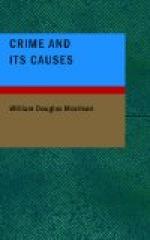Summing up our inquiries respecting the criminal type we arrive, in the first place, at the general conclusion, that so far as it has a real existence it is not born with a man, but originates either in the prison, and is then merely a prison type, or in criminal habits of life, and is then a truly criminal type. As a matter of fact, the two types are in most cases blended together, the prison type with its hard, impassive rigidity of feature being superadded to the gait, gesture and demeanour of the habitual criminal. In combination these two types form a professional type and constitute what Dr. Bruce Thomson[41] has called “a physique distinctly characteristic of the criminal class.” It is not, however, a type which admits of accurate description, and its practical utility is impaired by the fact that certain of its features are sometimes visible in men who have never been convicted of crime. The position of the case, with respect to the criminal type, may be best described by saying that an experienced detective officer will be sure in nine cases out of ten that he has got hold of a criminal by profession, but in the tenth case he will probably make a mistake. In other words, face, manner and demeanor are no infallible index of character or habits of life.
[41] Journal of Mental Science, vol. xvi.
When crime is not an inherited taint, but merely an acquired habit, this fact has an important practical bearing upon the proper method of dealing with it. Acquired habits, we are now being taught by Professor Weismann, are incapable of being transmitted to posterity, and Mr. Galton is of the same opinion.[42] This is not the place to elaborate the theory of inheritance, as understood by those writers; its essence, however, is that we only inherit the natural faculties of our forebears, and not those faculties which they have acquired by practice and experience. The son of a rope-dancer does not inherit his father’s faculties for rope-dancing, nor the son of an orator his father’s ready aptitude for public speech, nor the son of a designer his father’s acquired skill in the making of designs. All that the son inherits is the natural faculties of the parent, but no more. Hence it follows that the son of a thief, on the supposition that thieving comes by habit and practice, does not by natural inheritance acquire the parent’s criminal propensity. As far as his natural faculties are concerned he starts life free from the vicious habits of his parent, and should he in turn become a thief, as sometimes happens, it is not because he has inherited his father’s thievish habits, but because he has himself acquired them. It is imitation, not instinct, which transforms him into a thief; and if he is removed from the influence of evil example he will have almost as small a chance of falling into a criminal life as any other member of the community. It will not be quite so small, because no public institution, however well conducted, can ever exercise so moralising an effect as a good home, but it will be much smaller than if he grew up to maturity under the pernicious surroundings of a criminal home.




